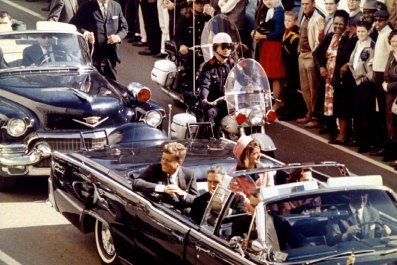The century-long interplay between technology and retail suggests Walmart is screwed. Its efforts to morph into an online retailer by buying Bonobos and Jet.com will end up making the company seem like Michael Jordan playing baseball—what made it great at one thing doesn't translate to another.
At the same time, Amazon is marching through the retail sector with the ruthlessness of General Sherman taking out Georgia, remaking shopping in its image. When the company said it will buy Whole Foods, we could imagine the combination resulting in futuristic drone-delivered Veganic Sprouted Ancient Maize Flakes, even though Amazon has said almost nothing about what it will do with the high-end grocer. (Please, at least introduce a new meat called Amazon Prime Rib.)
Long before Amazon, tech shaped retail, and that history gives us a hint of what's to come. Start back at the founding of Sears, in 1893. For its initial 30 years, Sears was solely a mail-order company, relying on the U.S. Postal Service and railroads for delivery. But the automobile was emerging as a new technology that would change society and alter the way people shop. There was now a relatively easy way to go to a store many miles away and bring items home. Sears's big innovation was to build big stores that catered to customers arriving in cars. It opened its first store in Chicago in 1925 and built stores across the country as the economy boomed in the two decades after World War II, luring shoppers who would drive in from newly built suburbs. By exploiting the tech of automobiles, Sears reigned as the nation's largest retailer into the 1980s.
In 1962, while Sears was winning the car era, Sam Walton opened his first Walmart, in Rogers, Arkansas. Over the next dozen years, he opened 125 stores in rural areas ignored by big retailers like Sears. Walmart wasn't an especially innovative retailer then, but another society-altering new technology was emerging: computing. In 1975, Walmart leased an IBM machine and started to collect data from all its stores. By the early 1980s, bar codes and systems to glean information from them were perfected. Walmart built huge centralized computing and wrote software to run its operations in ways established retailers couldn't yet imagine.
Walmart knew more about which products were selling in which locations than any retailer on the planet, so it could make better decisions about what to stock and thus make higher profits on lower prices than anyone else. Walmart rode the big computing era to domination, passing Sears in 1990 as the largest retailer by revenue. In 2002, it reached the top spot on the Fortune 500 list.
Yet Walmart's strength reveals what it missed. The company succeeded by knowing what its stores sold, not what individual customers bought. This is where Amazon, founded in 1994, enters the scene. Jeff Bezos started Amazon to take advantage of the embryonic internet, yet like the early years of Sears and Walmart, Amazon took a while to find its technological advantage. Because it sold directly to individuals through their computer screens, all interactions could be captured in data. Amazon could know what every customer buys and looks at.
In the late 1990s, the company started working on ways to use that information to recommend products based on your shopping habits. It had discovered the power of early artificial intelligence (AI). "Bezos believed this would be one of the insurmountable advantages of e-commerce over its brick-and-mortar counterparts," Brad Stone wrote in The Everything Store, his book about Amazon. Stone quotes Bezos saying, "Great merchants have never had the opportunity to understand their customers in a truly individualized way."
Amazon is the retailer of the AI era. Everything it does is designed to bring in data so its AI can learn how to better target and serve every individual customer. The company now has 300 million users, and about 20 percent of them buy from Amazon at least once a week. While Walmart knows more about stores than any other retailer, Amazon knows more about people, and that wins. Even as Amazon, ironically, opens bookstores, it's using what its AI learns about the people who live near each bookstore to decide what books to carry. Amazon's plans for Whole Foods will also probably have something to do with AI learning about individual customers. Either Whole Foods will help Amazon learn about a kale-munching customer sector it doesn't yet own or Amazon's AI will help it make each Whole Foods store irresistible to everyone in its neighborhood. Or both.
When Walmart bought Bonobos, it talked about how the innovative clothing retailer can help it learn about customers. But Walmart is not likely to ever catch its rival in AI learning about people. You can see that in the two companies' valuations. Walmart has about a $227 billion market cap on annual revenue of $482 billion. Amazon is valued at more than twice that ($472 billion) on much less revenue ($136 billion). Investors are anticipating a big upside to Amazon; not so much with Walmart.
Walmart is at a disadvantage to Amazon for other reasons too. Walmart operates almost 5,000 stores and employs 2 million people worldwide, an astounding expense compared with Amazon's 100-plus roboticized fulfillment centers and 341,000 employees. Amazon delivery appeals to people in cities, where more of the population is moving and generally thriving; Walmart's stores are geared to suburbs and rural areas, which in many parts of the U.S. have been hurting. Still, none of that compares to Amazon's technology advantage in AI and personalization.
And this AI era is only beginning. Walmart seems destined to become the next Sears—not next year but maybe in 10 or 15. Walmart is a great company. Sears was a great company. But technology shifts are merciless. Guaranteed, something that will profoundly alter retail is coming that Amazon won't see, and the company will face an existential challenge, as Sears and Walmart did before it. When? Probably about the time recently crowned NBA champ Stephen Curry tries to join the PGA Tour.




















